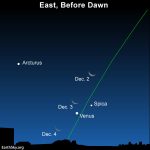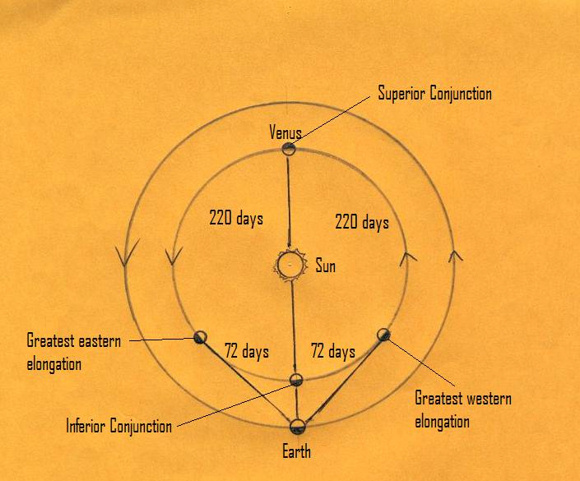
In the coming mornings – December 2, 3 and 4, 2018 – look eastward before sunrise for the moon and Venus. If your sky is clear, you can’t miss them! They’re always the brightest and second-brightest celestial bodies, respectively, to light up the night sky. Plus – around now – Venus is at its maximum brightness for this morning apparition, with its greatest illuminated extent falling around December 2.
The moon and Venus are so bright and beautiful that you’ll easily spot them at morning dawn. And, if you’re willing to get up an hour or two before sunrise, you can also see the bright star Arcturus to the north (left) of the moon and Venus, and the star Spica close to Venus.
If you peered at Venus through a telescope now, you’d find it in a waxing crescent phase. That’s because Venus passed between us and the sun on October 26, and its lighted half – or day side – is still facing mostly away from us. In early December, 2018, meanwhile, the moon is waning, and the phase of the waning crescent moon and waxing crescent Venus are almost identical. Both worlds are now showing us disks that are about one-quarter (25%) illuminated by sunshine. If you have a telescope, remember … you’ll get a crisper view of Venus’ phase at dawn, when this brilliant world has climbed higher above your horizon and its glare has been reduced by the breaking day.
Click here to find out the present phase of the moon and Venus
Venus in the predawn Tucson, Arizona sky on November 27, 2018. Eliot Herman wrote: “Venus is currently about as bright as it will be for this cycle, glowing in the eastern morning sky. Venus is amazingly bright! Crescent Venus inset captured with a Questar telescope, 50 mm lens and a Nikon D850.”
After today, the moon’s phase will continue to wane (get smaller) as the moon falls closer to the sunrise over the next several mornings. On December 5 and 6, 2018, the thin lunar crescent will swing by the planet Mercury, though Mercury will be quite hard to spot in the glow of morning twilight. Binoculars may help. See the chart below.
The good news is that Mercury is brightening day by day and, moreover, is coming up earlier by the day. So, by the middle of December, Mercury should become a fine morning object.

It’ll be tough to catch the slender crescent moon with the planet Mercury before sunrise December 5. But some of EarthSky’s eagle-eyed observers have surprised us before and might surprise us again! Submit your photo here, if you get one, or post in the comments below.
As the moon’s phase wanes, Venus’ phases waxes, as this world pulls ahead of us in its smaller, faster orbit, causing its illuminated or day side to slowly turn out way.
When Venus’ disk reaches its half-lit waxing quarter phase on January 6, 2019, this planet will be at its greatest elongation of 47 degrees west of the sun.
After Venus attains this milestone in the morning sky, this planet will begin slowly but surely sinking toward the sunrise. It’ll take many months to do this, as it moves ahead of us in orbit. Venus will finally pass more or less behind the sun from Earth – at what astronomers call superior conjunction – on August 14, 2019. At that juncture, Venus will transition out of the morning sky and into evening sky. See the diagram below.

The Earth and Venus orbit the sun counterclockwise as seen to the north of the solar system plane. When Venus is to the east (left) of the Earth-sun line, we see Venus as an evening “star” in the west after sunset. After Venus reaches its inferior conjunction, Venus then moves to the west (right) of the Earth- sun line, appearing as a morning “star” in the east before sunrise.
Now back to the current month! The moon will turn new, to swing more or less between the sun and Earth, on December 7, 2018. At that time, the moon will transition from the morning to the evening sky.
Mercury and Venus are called inferior planets because they orbit the sun inside of Earth’s orbit. Although Venus is about twice Mercury’s distance from the sun, Venus is nonetheless the hotter of these two worlds. Climate does not depend on the sun alone but also on a planet’s atmosphere. Venus’ thick atmosphere creates a greenhouse effect that brings Venus’ surface temperature to 864 degrees Fahrenheit (462 degrees Celsius). Read more here.
Even though the moon and Earth are virtually the same distance from the sun, the moon’s daytime temperature is much hotter, and its nighttime temperature is much colder, than here on Earth. That’s because Earth has a protective atmosphere whereas the moon has no atmosphere of significance. Read more.
Bottom line: These next several mornings – December 2 to 4, 2018 – watch for the waning crescent moon to sweep by Venus, the solar system’s hottest planet. Some of you might also catch the moon near Mercury, the solar system’s innermost planet, on December 5.
from EarthSky https://ift.tt/2FPcmJm

In the coming mornings – December 2, 3 and 4, 2018 – look eastward before sunrise for the moon and Venus. If your sky is clear, you can’t miss them! They’re always the brightest and second-brightest celestial bodies, respectively, to light up the night sky. Plus – around now – Venus is at its maximum brightness for this morning apparition, with its greatest illuminated extent falling around December 2.
The moon and Venus are so bright and beautiful that you’ll easily spot them at morning dawn. And, if you’re willing to get up an hour or two before sunrise, you can also see the bright star Arcturus to the north (left) of the moon and Venus, and the star Spica close to Venus.
If you peered at Venus through a telescope now, you’d find it in a waxing crescent phase. That’s because Venus passed between us and the sun on October 26, and its lighted half – or day side – is still facing mostly away from us. In early December, 2018, meanwhile, the moon is waning, and the phase of the waning crescent moon and waxing crescent Venus are almost identical. Both worlds are now showing us disks that are about one-quarter (25%) illuminated by sunshine. If you have a telescope, remember … you’ll get a crisper view of Venus’ phase at dawn, when this brilliant world has climbed higher above your horizon and its glare has been reduced by the breaking day.
Click here to find out the present phase of the moon and Venus
Venus in the predawn Tucson, Arizona sky on November 27, 2018. Eliot Herman wrote: “Venus is currently about as bright as it will be for this cycle, glowing in the eastern morning sky. Venus is amazingly bright! Crescent Venus inset captured with a Questar telescope, 50 mm lens and a Nikon D850.”
After today, the moon’s phase will continue to wane (get smaller) as the moon falls closer to the sunrise over the next several mornings. On December 5 and 6, 2018, the thin lunar crescent will swing by the planet Mercury, though Mercury will be quite hard to spot in the glow of morning twilight. Binoculars may help. See the chart below.
The good news is that Mercury is brightening day by day and, moreover, is coming up earlier by the day. So, by the middle of December, Mercury should become a fine morning object.

It’ll be tough to catch the slender crescent moon with the planet Mercury before sunrise December 5. But some of EarthSky’s eagle-eyed observers have surprised us before and might surprise us again! Submit your photo here, if you get one, or post in the comments below.
As the moon’s phase wanes, Venus’ phases waxes, as this world pulls ahead of us in its smaller, faster orbit, causing its illuminated or day side to slowly turn out way.
When Venus’ disk reaches its half-lit waxing quarter phase on January 6, 2019, this planet will be at its greatest elongation of 47 degrees west of the sun.
After Venus attains this milestone in the morning sky, this planet will begin slowly but surely sinking toward the sunrise. It’ll take many months to do this, as it moves ahead of us in orbit. Venus will finally pass more or less behind the sun from Earth – at what astronomers call superior conjunction – on August 14, 2019. At that juncture, Venus will transition out of the morning sky and into evening sky. See the diagram below.

The Earth and Venus orbit the sun counterclockwise as seen to the north of the solar system plane. When Venus is to the east (left) of the Earth-sun line, we see Venus as an evening “star” in the west after sunset. After Venus reaches its inferior conjunction, Venus then moves to the west (right) of the Earth- sun line, appearing as a morning “star” in the east before sunrise.
Now back to the current month! The moon will turn new, to swing more or less between the sun and Earth, on December 7, 2018. At that time, the moon will transition from the morning to the evening sky.
Mercury and Venus are called inferior planets because they orbit the sun inside of Earth’s orbit. Although Venus is about twice Mercury’s distance from the sun, Venus is nonetheless the hotter of these two worlds. Climate does not depend on the sun alone but also on a planet’s atmosphere. Venus’ thick atmosphere creates a greenhouse effect that brings Venus’ surface temperature to 864 degrees Fahrenheit (462 degrees Celsius). Read more here.
Even though the moon and Earth are virtually the same distance from the sun, the moon’s daytime temperature is much hotter, and its nighttime temperature is much colder, than here on Earth. That’s because Earth has a protective atmosphere whereas the moon has no atmosphere of significance. Read more.
Bottom line: These next several mornings – December 2 to 4, 2018 – watch for the waning crescent moon to sweep by Venus, the solar system’s hottest planet. Some of you might also catch the moon near Mercury, the solar system’s innermost planet, on December 5.
from EarthSky https://ift.tt/2FPcmJm

Aucun commentaire:
Enregistrer un commentaire